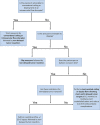Staged endovascular treatment of a coexisting parasellar aneurysm and endoscopic resection of a pituitary macroadenoma: illustrative case
- PMID: 36130536
- PMCID: PMC9379633
- DOI: 10.3171/CASE21699
Staged endovascular treatment of a coexisting parasellar aneurysm and endoscopic resection of a pituitary macroadenoma: illustrative case
Abstract
Background: Intracranial aneurysms and pituitary adenomas are relatively common pathologies that, in rare instances, may concurrently present. Their management poses considerable clinical and technical challenges.
Observations: The authors present a case of a 66-year-old female patient with a fusiform aneurysm of the left internal carotid artery associated with a symptomatic pituitary macroadenoma that had been causing visual deficits for the past several years. She underwent successful placement of flow diverter stents across her aneurysm, followed by routine dual antiplatelet therapy to maintain stent patency. She underwent frequent serial radiographic, endocrine, and ophthalmological evaluations during this time to ensure stability of her pituitary adenoma. Following confirmation of aneurysm obliteration and subsequent de-escalation of antiplatelet medications to aspirin monotherapy, her tumor was subsequently resected via an endoscopic endonasal approach in a delayed fashion.
Lessons: The authors review the literature regarding management of these concurrent pathologies and describe the aspects of the case that led them to their chosen treatment strategy. An algorithm is proposed regarding the management of parasellar aneurysms with a concurrent diagnosis of pituitary tumor pathology.
Keywords: endonasal endoscopic approach; fusiform aneurysm; intracranial aneurysm; parasellar; pituitary adenoma.
Conflict of interest statement
Figures




Similar articles
-
Management of Coincident Pituitary Macroadenoma and Cavernous Carotid Aneurysm: A Systematic Literature Review.J Neurol Surg Rep. 2021 Sep 29;82(3):e25-e31. doi: 10.1055/s-0041-1735904. eCollection 2021 Jul. J Neurol Surg Rep. 2021. PMID: 34603930 Free PMC article.
-
Endoscopic endonasal approach for simultaneously treating a pituitary adenoma coexisting with a paraclinoid aneurysm: illustrative case.J Neurosurg Case Lessons. 2022 Jun 20;3(25):CASE22130. doi: 10.3171/CASE22130. eCollection 2022 Jun 20. J Neurosurg Case Lessons. 2022. PMID: 35733842 Free PMC article.
-
Expanded endonasal endoscopic approach for resection of a growth hormone-secreting pituitary macroadenoma coexistent with a cavernous carotid artery aneurysm.J Clin Neurosci. 2012 Oct;19(10):1437-41. doi: 10.1016/j.jocn.2011.11.032. Epub 2012 Jul 25. J Clin Neurosci. 2012. PMID: 22836036
-
Endovascular management of internal carotid artery injuries secondary to endonasal surgery: case series and review of the literature.J Neurosurg. 2016 Nov;125(5):1256-1276. doi: 10.3171/2015.6.JNS142483. Epub 2016 Jan 15. J Neurosurg. 2016. PMID: 26771847 Review.
-
Endoscopic Endonasal Surgery for Remission of Cushing Disease Caused by Ectopic Intracavernous Macroadenoma: Case Report and Literature Review.World Neurosurg. 2017 Feb;98:870.e5-870.e10. doi: 10.1016/j.wneu.2016.12.021. Epub 2016 Dec 18. World Neurosurg. 2017. PMID: 28003168 Review.
Cited by
-
Surgical treatment of pituitary neuroendocrine tumors with coexisting intracranial lesions: A case series and review of the literature.Surg Neurol Int. 2024 Mar 22;15:96. doi: 10.25259/SNI_22_2024. eCollection 2024. Surg Neurol Int. 2024. PMID: 38628542 Free PMC article.
References
-
- Bulsara KR, Karavadia SS, Powers CJ, Paullus WC. Association between pituitary adenomas and intracranial aneurysms: an illustrative case and review of the literature. Neurol India. 2007;55(4):410–412. - PubMed
-
- Raper DM, Ding D, Evans E, et al. Clinical features, management considerations and outcomes in case series of patients with parasellar intracranial aneurysms undergoing anterior skull base surgery. World Neurosurg. 2017;99:424–432. - PubMed
-
- Sade B, Mohr G, Tampieri D, Rizzo A. Intrasellar aneurysm and a growth hormone-secreting pituitary macroadenoma. Case report. J Neurosurg. 2004;100(3):557–559. - PubMed
-
- Seda L, Jr, Cukiert A, Nogueira KC, Huayllas MK, Liberman B. Intrasellar internal carotid aneurysm coexisting with GH-secreting pituitary adenoma in an acromegalic patient. Arq Neuropsiquiatr. 2008;66(1):99–100. - PubMed
-
- Yang MY, Chen C, Shen CC. Cavernous aneurysm and pituitary adenoma: management of dual intrasellar lesions. J Clin Neurosci. 2005;12(4):477–481. - PubMed
LinkOut - more resources
Full Text Sources
Miscellaneous

